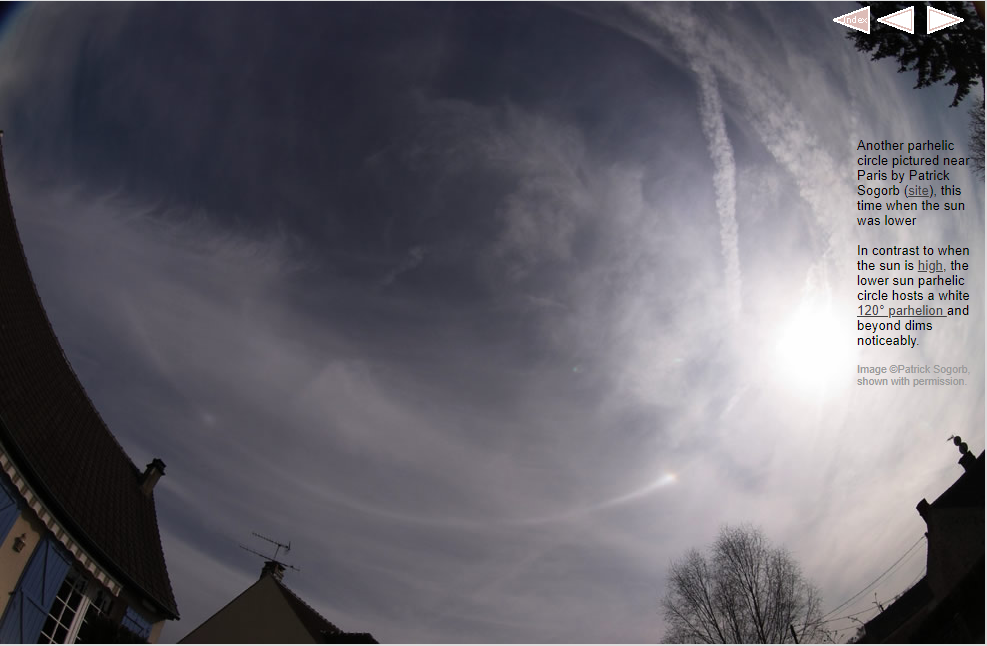Parhelic cicle, low sun, Paris
Parhelic Circle: A Phenomenon of Atmospheric Optics
The parhelic circle is a fascinating atmospheric optical phenomenon that can be observed when the sun is low in the sky. It forms a complete circle around the sun and is caused by the reflection, refraction, and scattering of sunlight by ice crystals in the atmosphere. While parhelic circles are relatively rare, they offer a captivating spectacle for those lucky enough to witness them. In this article, we will delve into the details of the parhelic circle phenomenon, particularly when the sun is low in Paris.
The Parhelic Circle with a Low Sun in Paris
In Paris, the parhelic circle takes on a unique appearance when the sun is positioned lower in the sky. This variation in solar elevation alters the characteristics of the parhelic circle, resulting in distinct visual features. One notable difference is the presence of a white 120° parhelion, which is a bright spot of light located at an angle of 120 degrees from the sun. Additionally, the overall brightness of the parhelic circle diminishes as the sun descends, lending an ethereal quality to the phenomenon.
Understanding the Formation of Parhelic Circles
Parhelic circles are formed through a combination of light refraction and reflection by ice crystals in the atmosphere. These ice crystals are typically found in cirrus clouds or diamond dust, which consist of tiny ice particles suspended in the air. When sunlight passes through these ice crystals, it undergoes refraction, causing the light rays to change direction. As a result, the sunlight is spread out into a circular pattern around the sun, forming the parhelic circle.
The Role of Ice Crystals in Parhelic Circle Formation
The shape and orientation of ice crystals play a crucial role in determining the appearance of the parhelic circle. Ice crystals with flat, hexagonal shapes are particularly adept at producing the parhelic circle phenomenon. These crystals act as tiny prisms, refracting the sunlight and creating the circular pattern. The orientation of the crystals also influences the angle at which the parhelic circle is observed, giving it a distinct shape and position relative to the sun.
The Influence of Solar Elevation on Parhelic Circles
The position of the sun in the sky has a significant impact on the appearance of the parhelic circle. When the sun is high, the parhelic circle is more pronounced and vibrant. However, as the sun lowers towards the horizon, the parhelic circle becomes dimmer and less prominent. This change in brightness is attributed to the longer atmospheric path that sunlight must traverse when the sun is lower, resulting in increased scattering and absorption of light by the atmosphere.
Other Atmospheric Optics Phenomena Associated with Parhelic Circles
Parhelic circles are often accompanied by other atmospheric optical phenomena, further enhancing their visual spectacle. Some of these phenomena include:
- Sundogs: These are bright spots of light that appear on either side of the sun, caused by the refraction of sunlight by ice crystals.
- Sun pillars: Vertical columns of light that extend above or below the sun, created by the reflection of sunlight off ice crystals.
- Circumzenithal arcs: Colorful arcs that form at a higher angle than the parhelic circle, caused by sunlight passing through horizontally oriented ice crystals.
Capturing the Beauty of Parhelic Circles
Photographers and enthusiasts are captivated by the mesmerizing beauty of parhelic circles. To capture these phenomena, it is essential to have a clear view of the sky with minimal obstructions. Using a wide-angle lens can help capture the full extent of the parhelic circle and its accompanying optical effects. Patience and timing are crucial, as parhelic circles are transient and can appear and disappear rapidly. With the right conditions and equipment, photographers can immortalize the enchanting allure of parhelic circles for others to admire.
Appreciating the Wonder of Atmospheric Optics
Parhelic circles, especially when the sun is low in Paris, offer a stunning display of the intricacies of atmospheric optics. These phenomena serve as a reminder of the awe-inspiring beauty and complexity of the natural world. By understanding the science behind parhelic circles and other atmospheric optical phenomena, we can gain a deeper appreciation for the wonders that surround us. So, keep your eyes to the sky, for you never know when you might witness the magical dance of light and ice crystals that creates the mesmerizing parhelic circle.

Another parhelic circle pictured near Paris by Patrick Sogorb (site), this time when the sun was lower
In contrast to when the sun is high, the lower sun parhelic circle hosts a white 120° parhelion and beyond dims noticeably.
Image ©Patrick Sogorb, shown with permission.
Note: this article has been automatically converted from the old site and may not appear as intended. You can find the original article here.
Reference Atmospheric Optics
If you use any of the definitions, information, or data presented on Atmospheric Optics, please copy the link or reference below to properly credit us as the reference source. Thank you!
-
<a href="https://atoptics.co.uk/blog/parhelic-cicle-low-sun-paris/">Parhelic cicle, low sun, Paris</a>
-
"Parhelic cicle, low sun, Paris". Atmospheric Optics. Accessed on April 16, 2024. https://atoptics.co.uk/blog/parhelic-cicle-low-sun-paris/.
-
"Parhelic cicle, low sun, Paris". Atmospheric Optics, https://atoptics.co.uk/blog/parhelic-cicle-low-sun-paris/. Accessed 16 April, 2024
-
Parhelic cicle, low sun, Paris. Atmospheric Optics. Retrieved from https://atoptics.co.uk/blog/parhelic-cicle-low-sun-paris/.